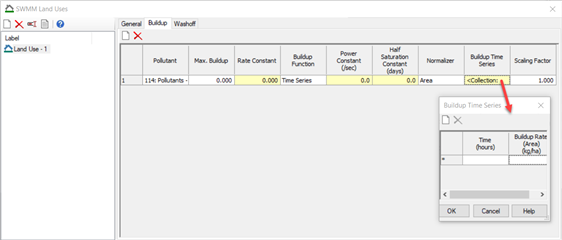| Product(s): |
SewerGEMS, CivilStorm |
| Version(s): |
CONNECT Edition, V8i |
| Area: |
Modeling |
Problem
What are the capabilities of SewerGEMS and CivilStorm in terms of modeling water quality characteristics of sewer system?
Solution
There are two methods for loading pollutants in a water quality simulation:
1. Point (node) load, which involves assigning a pollutograph to a node element (such as a manhole or a cross section). This method is used for point loads such as industrial dischargers or normal domestic customers.
2. Catchment runoff, where the pollutant enters the system based on one of several different washoff functions for each land use assigned to a catchment. In long-term runs, you can specify the rate at which pollutants build up on the catchment surface (and are possibly removed by treatments such as street sweeping).

Modeling transport of pollutants
In addition to the H2S prediction feature of SewerGEMS and CivilStorm with explicit (SWMM) solver (see link below), it also has capability of modeling transport of pollutants in a system as point loads. It can handle pollutants e.g. pesticides or those who follow first order decay e.g. BOD, COD etc.
Pollutant information can be entered through Components > SWMM extensions > Pollutants.
Any number of pollutants may be defined in a SWMM model and be included in a simulation provided that:
1. They can be expressed as a concentration of either mass or number (for biological organisms) per volume of water,
2. Their masses are additive, meaning that the concentration of two equal volumes of water mixed together is the sum of the individual concentrations.
Co-pollutants are useful for representing constituents that can appear in either dissolved or solid forms (e.g., BOD, metals, phosphorus) and may be adsorbed onto other constituents (e.g., pesticides onto “solids”) and thus be generated as a portion or fraction of such other constituents.

Modeling buildup/washoff of pollutants
Buildup of pollutants on a catchment and washoff during precipitation can also be modeled. For this, Land use can be accessed from Components > SWMM Extensions > Land use. Other capabilities are snowpack, aquifers modeling etc.
Land Uses are categories of development activities or land surface characteristics assigned to subcatchments. Examples of land use activities are residential, commercial, industrial, and undeveloped. Land surface characteristics might include rooftops, lawns, paved roads, undisturbed soils, etc. Land uses are used solely to account for spatial variation in pollutant buildup and washoff rates within subcatchments.

With the EPA-SWMM solver, the user has many options for defining land uses and assigning them to subcatchment areas. One approach is to assign a mix of land uses for each subcatchment, which results in all land uses within the subcatchment having the same pervious and impervious characteristics. Another approach is to create subcatchments that have a single land use classification along with a distinct set of pervious and impervious characteristics that reflects the classification. If surface buildup and washoff is not being modeled, such as when pollutant inflows come only from wet deposition, dry weather sanitary flows, and external time series flows, then there is no need to add land uses into a project.
To model an initial buildup of pollutants at the start of the simulation, use the "initial buildup collection" field - click the ellipsis button to add an initial buildup value for each pollutant. If this is not specified, the program will assume that there is no initial buildup of pollutants at the start of the simulation. If a value is entered, in the collection, it will override any initial buildup computed from the Antecedent Dry Days parameter specified.
Defining Pollutographs
Pollutographs are plots of time vs. mass rate or time vs. concentration, depending on which constituent inflow type you choose (mass or concentration). You create pollutographs in the Pollutographs dialog box from Components > SWMM Extensions > Pollutographs and add them to individual manholes in your model using the node's Property Editor.
For Mass-based pollutographs (mass rate over time), a Mass Units Conversion Factor is defined, which is used to convert the units of pollutant mass flow rate into concentration mass units per second. This is the "Units Factor" mentioned in the EPA-SWMM documentation. For example, if the inflow data were in lbs/day and the pollutant concentration was chosen as mg/L, then the conversion factor value would be (453,590 mg/lb) / (86,400 sec/day) = 5.25 (mg/sec) per (lb/day). This field does not appear for FLOW inflow, and for concentration-type inflows any value entered will be overridden to 1.0.
If a pollutant is assigned a direct inflow in terms of concentration, then one must also assign a time series inflow to flow, otherwise no pollutant inflow will occur. An exception is at submerged outfalls where pollutant intrusion can occur during periods of reverse flow. If pollutant inflow is defined in terms of mass, then a corresponding flow inflow is not required.
View Results
To view pollutant results, go the element properties and open the Pollutant Collection field.

You will be able to see the concentration results based on time displayed as a graph of concentration versus time. Switching to the Data tab will give tabular results.
Troubleshooting
No pollutant results seen after a virtual link, pump, pressure pipe or pressure junction
This is a known issue in version 10.03.04.53 and earlier due to the pollutant results not being saved for pressure elements. The results are still calculated and you can view the pollutant results in the next-downstream gravity manhole/conduit element. If you need to see results in the pressure elements, contact Technical Support for a patch for version 10.03.04.53 (reference #805841) or upgrade to a newer version when available.
See Also
Modeling septicity / hydrogen sulfide (H2S)
SWMM water quality User Manual
How can I use CivilStorm to evaluate TSS removal efficiency in a detention pond?
Training